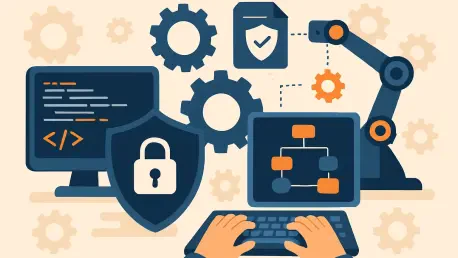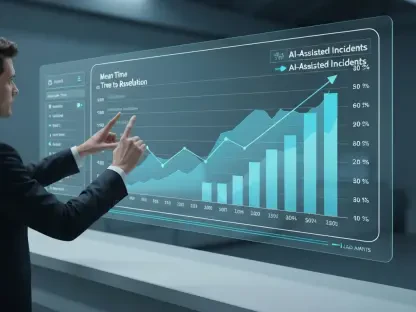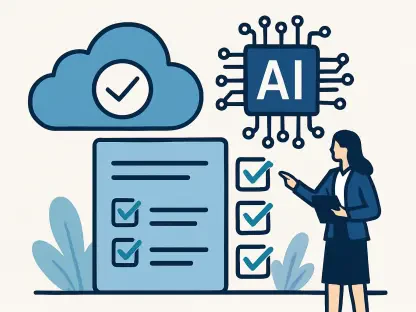In an era where digital transformation accelerates at an unprecedented pace, the specter of cyber threats casts a long shadow over software development and operations, demanding a seamless integration of security practices to safeguard innovation. The DevSecOps methodology, designed to embed security throughout the development lifecycle, offers a promising path to mitigate risks while maintaining the speed that modern businesses require. Yet, as organizations grapple with balancing rapid delivery against robust protection, they often encounter significant hurdles—cultural misalignments, technical inefficiencies, and overwhelmed teams. These challenges reveal a critical gap in current approaches, where the promise of DevSecOps falls short without the right strategies. This exploration delves into an innovative solution known as Security as Code (SaC), a paradigm that harnesses automation to revolutionize DevSecOps. By reimagining security as an integral, programmable component of the development pipeline, SaC aims to bridge existing divides and transform how security is perceived and implemented in a digital-first world.
Navigating the Complexities of DevSecOps Today
The urgency for effective security measures in software development has reached a critical point, especially when statistics reveal that over 80% of vulnerabilities originate from open-source and third-party components. As the DevSecOps market surges toward a staggering $45.93 billion valuation, the pressure on organizations to adapt is immense. However, a persistent tension exists between the need for rapid deployment and the stringent demands of security protocols. Developers, caught in this crossfire, often dedicate nearly a fifth of their weekly hours—roughly 8 hours—to security-related tasks. This not only contributes to burnout but also imposes a significant financial burden on companies, with costs per developer running into thousands annually. The strain of managing these responsibilities, compounded by fragmented workflows, highlights a deeper issue: without addressing the root causes of inefficiency, DevSecOps risks becoming a bottleneck rather than a facilitator of progress in the digital landscape.
Beyond the workload, the broader impact of these challenges on organizational efficiency cannot be overlooked. When developers are bogged down by security tasks outside their core expertise, innovation takes a backseat, and project timelines stretch unnecessarily. The constant context-switching between development and security duties erodes focus, leading to errors and diminished productivity. Moreover, the lack of streamlined processes often results in inconsistent security implementations, leaving gaps that cyber threats can exploit. This scenario underscores a critical flaw in many DevSecOps setups—while the intent to integrate security is present, the execution often lacks the necessary cohesion to support teams effectively. Addressing this requires more than just willpower; it demands a rethinking of how security responsibilities are distributed and managed across the development lifecycle, ensuring that speed and safety are not mutually exclusive goals but complementary strengths.
The Dual Edge of Shifting Security Left
A cornerstone of modern DevSecOps philosophy is the concept of shifting security left, which emphasizes embedding protective measures early in the development cycle to preempt issues before they escalate. This proactive approach yields tangible benefits, such as significantly lower costs for fixing vulnerabilities during the coding phase compared to post-deployment remediation. Real-time feedback loops enhance developer productivity by reducing delays, while early intervention has been shown to cut vulnerability risks by as much as 50% in some studies. Organizations adopting this strategy often find that it aligns security with business objectives, fostering a more resilient product ecosystem. However, the success of this method hinges on proper implementation, as the shift left can inadvertently create new challenges if not supported by the right tools and training, potentially undermining the very advantages it seeks to deliver.
Despite its promise, shifting security left places an undeniable burden on development teams, who are often ill-equipped to handle the added responsibilities without adequate resources. The expectation to manage security alongside coding duties can overwhelm developers, particularly when they lack familiarity with the specialized tools required. This overload not only slows down the development process but also risks creating friction between security and development teams, as priorities clash. Without clear guidelines or supportive frameworks, the shift left can transform from a strategic advantage into a source of frustration, where the focus on early security integration inadvertently hampers efficiency. To mitigate this, organizations must prioritize equipping developers with accessible solutions and fostering an environment where security tasks are seamlessly integrated into daily workflows, ensuring that the benefits of early intervention are realized without compromising team morale or project timelines.
The Hidden Costs of Tool Proliferation
Adding an array of security tools to the development pipeline might seem like a logical step to bolster DevSecOps, but this approach often backfires by introducing more complexity than clarity. With developers frequently managing between 11 and 14 distinct tools, the resulting sprawl fragments workflows and creates inefficiencies across teams. Security personnel lose critical visibility into processes, while operations struggle to maintain consistency in how protections are applied. This disjointed setup not only heightens the risk of human error but also breeds frustration, as teams grapple with incompatible systems and overlapping functionalities. The lesson here is clear: piling on technology without a cohesive strategy fails to address the underlying issues in DevSecOps and instead exacerbates the very bottlenecks it aims to resolve, leaving organizations vulnerable despite their investments.
The repercussions of tool overload extend beyond mere operational hiccups, impacting the cultural fabric of DevSecOps initiatives as well. When teams are inundated with disparate systems, collaboration suffers, and silos between development, security, and operations deepen. Developers, already stretched thin, find themselves navigating unfamiliar interfaces, while security experts struggle to enforce policies in an environment of constant flux. This lack of alignment often results in inconsistent security postures, where critical vulnerabilities slip through the cracks due to miscommunication or oversight. Addressing this challenge requires a fundamental shift away from tool-centric solutions toward a more integrated model that prioritizes simplicity and interoperability. Only by streamlining the technological landscape can organizations hope to foster the shared responsibility and trust necessary to make DevSecOps a sustainable, effective practice in the long term.
Redefining Security with a Code-Based Approach
At the heart of transforming DevSecOps lies Security as Code (SaC), an innovative framework that reimagines security as programmable, version-controlled, and testable elements seamlessly embedded into development workflows. This approach breaks down into key components: defining security policies through structured formats like YAML or JSON for automated enforcement, securing infrastructure with tools such as Terraform for consistent configurations, and integrating application security controls via reusable code libraries to ensure uniformity across environments. By eliminating manual interventions and late-stage reviews, SaC enhances traceability and reproducibility, turning security into a scalable, integral part of the pipeline. This method not only reduces human error but also aligns security practices with the agility of modern development, offering a practical solution to the persistent challenges faced by teams striving to balance speed with robust protection.
The adoption of SaC represents a significant departure from traditional security models, focusing on automation to alleviate the pressures on development teams. By codifying security rules and configurations, organizations can ensure that protective measures are applied consistently from the earliest stages of development through to deployment. This systematic integration minimizes the risk of oversight and reduces the cognitive load on developers, who no longer need to juggle multiple manual processes or unfamiliar tools. Furthermore, SaC fosters accountability through version control, allowing teams to track changes and roll back configurations if needed, much like they would with application code. As a result, security evolves from a reactive checkpoint into a proactive enabler, empowering organizations to maintain high standards of protection without sacrificing the speed or innovation that competitive markets demand in today’s digital ecosystem.
Automation: Paving the Way Forward
The industry’s pivot toward automation signals a broader recognition that outdated, reactive security models are ill-suited to the fast-paced nature of modern software development. Security as Code aligns perfectly with this trend, positioning security not as an obstacle but as a strategic asset that enhances resilience and accelerates threat response. By embedding automated security practices into the development pipeline, organizations can build systems that withstand evolving cyber risks while maintaining customer trust through reliable, secure products. This shift reduces the burden on developers, who benefit from streamlined processes that integrate seamlessly with their existing workflows. Automation through SaC also promotes a culture of collaboration, where security becomes a shared priority across development, operations, and security teams, breaking down silos and fostering a unified approach to safeguarding digital assets.
Looking ahead, the potential of automation in DevSecOps extends beyond immediate operational gains to long-term strategic advantages. As threats grow in sophistication, the ability to codify and automate security responses ensures scalability, allowing organizations to adapt quickly without overhauling entire systems. This forward-thinking approach also supports compliance with increasingly stringent regulations, as automated policies can be updated and enforced uniformly across environments. By investing in solutions like SaC, companies position themselves to not only address current challenges but also anticipate future risks, turning security into a competitive edge. The journey toward a fully automated DevSecOps framework may require initial effort in training and cultural adaptation, but the payoff—enhanced efficiency, reduced vulnerabilities, and stronger market trust—marks it as a critical step for any organization aiming to thrive in an increasingly complex digital landscape.
Embracing a Secure Tomorrow
Reflecting on the evolution of DevSecOps, it becomes evident that early struggles with cultural divides and tool sprawl have hindered progress, often leaving teams frustrated despite their best efforts. Security as Code emerges as a pivotal innovation, offering a structured, automated path that alleviates developer burdens and integrates protection seamlessly into workflows. The industry’s embrace of this approach marks a turning point, where collaboration across teams strengthens, and security transforms into a driver of business value. As organizations move forward, the focus should shift to scaling these solutions through strategic partnerships and continuous training, ensuring that automation keeps pace with emerging threats. Exploring Security-as-a-Service models could further enhance flexibility, while fostering a mindset of shared responsibility will solidify security as a cornerstone of innovation, guiding companies toward a future where safety and speed coexist harmoniously.









